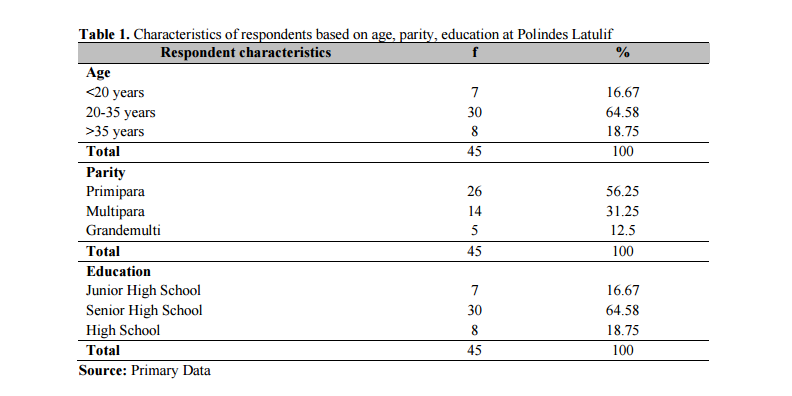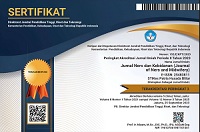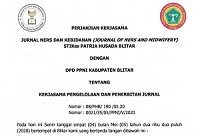The Analysis of Screening for Preeclampsia with the Maternal and Child Health Book
DOI:
https://doi.org/10.26699/jnk.v12i2.ART.p098-105Keywords:
Pre-eclampsia, MAP, ROT, BMIAbstract
Preeclampsia is a complication that occurs during pregnancy, childbirth, and the postpartum period, characterized by hypertension, edema, and proteinuria. The government is trying various programs to reduce the incidence of pre-eclampsia. In addition to pre-eclampsia screening instruments, the results of documentation data in the Maternal and Child Health Book have many opportunities for analysis, to be used as indicators for early detection of pre-eclampsia. This study aimed to analyze the use of the maternal and child health book for early detection of Pre-Eclampsia. The research design was a correlational analysis with a cross-sectional approach. The sample was some pregnant women in Trimester II and III with research criteria, aged 20-35 years, primigravida and multigravida, gestational age ≥16 weeks, a total of 45 people, with a Purposive sampling technique. The independent variables were MAP (Mean Arterial Pressure), ROT (Roll Over Test), and BMI (Body Mass Index). The dependent variable was the incidence of Preeclampsia in pregnancy. The data Analysis used the Chi-Square test. The results obtained the greater the MAP and ROT value the greater the risk of preeclampsia, and obesity has a two times greater risk of preeclampsia. Increased MAP, ROT, and BMI indicate changes in the vascular system, disrupting the balance between vasodilator and vasoconstrictor factors, which can cause increased vascular resistance. which is a characteristic of preeclampsia. ROT and MAP measurements need to be carried out in each trimester so that early management can be carried out if pre-eclampsia occurs.
References
Agung Mulyaningsih, E. (2020). Pengaruh Pemanfaatan Buku KIA dalam Pengkajian ROT dan MAP terhadap Deteksi Dini Pre Eklamsia di Polindes. In PROFESIONAL HEALTH JOURNAL (Vol. 1, Issue 2).
Black, K. D., & Morin, K. H. (2014). Development and testing of the preeclampsia prenatal symptom-monitoring checklist (PPSMC). Journal of Nursing Measurement, 22(1), 14–28. https://doi.org/10.1891/1061-3749.22.1.14
Chaemsaithong, P., Sahota, D. S., & Poon, L. C. (2022). First trimester preeclampsia screening and prediction. In American Journal of Obstetrics and Gynecology (Vol. 226, Issue 2, pp. S1071-S1097.e2). Elsevier Inc. https://doi.org/10.1016/j.ajog.2020.07.020
Continuing Education CE 1.5HOURS Preeclampsia: Current Approaches to Nursing Management. (2017).
Dini Kurniawati, Adilah Mia Azubah, Eka Afdi Septiyono, Iis Rahmawati, & Lantin Sulistyorini. (2023). Tanda dan Gejala pada Kehamilan dengan Preeklampsia di Wilayah Pertanian Jember. SEHATMAS: Jurnal Ilmiah Kesehatan Masyarakat, 2(4), 1064–1072. https://doi.org/10.55123/sehatmas.v2i4.2578
Gallo, D., Poon, L. C., Fernandez, M., Wright, D., & Nicolaides, K. H. (2014). Prediction of preeclampsia by mean arterial pressure at 11-13 and 20-24 weeks’ gestation. Fetal Diagnosis and Therapy, 36(1), 28–37. https://doi.org/10.1159/000360287
Karmilah, K., & Mochartini, T. (2024). Kajian skrining risiko hipertensi pada kehamilan menggunakan buku KIA pada usia kehamilan 20 minggu di Posyandu Batujaya. Holistik Jurnal Kesehatan, 18(4), 532–540. https://doi.org/10.33024/hjk.v18i4.189
Juwita, A., Yani, E. R., Yudianti, I., K., Zulaida, I. P., Wahyuntari, E., & Susanti, A. J. (2022). Skrining Preeklamsia dengan Metode Pengukuran Mean Arterial Pressure (MAP) Preeclampsia Screening with Mean Arterial Pressure (MAP). 8(1). https://doi.org/10.21070/midwiferia.v%vi%i.1634
Mosimann, B., Amylidi-Mohr, S. K., Surbek, D., & Raio, L. (2020). FIRST TRIMESTER SCREENING FOR PREECLAMPSIA–A SYSTEMATIC REVIEW. In Hypertension in Pregnancy (Vol. 39, Issue 1, pp. 1–11). Taylor and Francis Ltd. https://doi.org/10.1080/10641955.2019.1682009
Ranti, (2022). Jurnal Endurance, 7(2), 416–425. https://doi.org/10.22216/jen.v7i2.871
Serra, B., Mendoza, M., Scazzocchio, E., Meler, E., Nolla, M., Sabrià, E., Rodríguez, I., & Carreras, E. (2020). A new model for screening for early-onset preeclampsia. American Journal of Obstetrics and Gynecology, 222(6), 608.e1-608.e18. https://doi.org/10.1016/j.ajog.2020.01.020
Zhu, J., Zhang, J., Syaza Razali, N., Chern, B., & Tan, K. H. (2021). Mean arterial pressure for predicting preeclampsia in Asian women: A longitudinal cohort study. BMJ Open, 11(8). https://doi.org/10.1136/bmjopen-2020-046161
Costa, F. da S., Murthi, P., Keogh, R., & Woodrow, N. (2011). Early screening for preeclampsia. Revista Brasileira de Ginecologia e Obstetricia, 33(11), 367–375. https://doi.org/10.1590/S0100-72032011001100008
Esyuananik, E., Wayanti, S., Wulan, D. W., & Irawati, D. (2020). Pemanfaatan Roll Over Test Dan Mean Artery Pressure Dalam Deteksi Dini Risiko Preeklampsia. Jurnal Pengabdian Masyarakat Sasambo, 2(1), 134. https://doi.org/10.32807/jpms.v2i1.602
Husaidah, S., Mappaware, N. A., & Aminuddin. (2020). Change in Mean Arterial Pressure (MAP), Roll Over Test (ROT), and Soluble Fms Level like Tyrosine Kinase-1 (SFLT-1) as a predictor of preeclampsia in a pregnant woman by giving ajwa date. Enfermeria Clinica, 30, 325–330. https://doi.org/10.1016/j.enfcli.2020.06.073
Paauw, N. D., Luijken, K., Franx, A., Verhaar, M. C., & Titia Lely, A. (2016). Long-term renal and cardiovascular risk after preeclampsia: Towards screening and prevention. Clinical Science, 130(4), 239–246. https://doi.org/10.1042/CS20150567
Panaitescu, A., Ciobanu, A., Syngelaki, A., Wright, A., Wright, D., & Nicolaides, K. H. (2018). Screening for pre-eclampsia at 35–37 weeks’ gestation. Ultrasound in Obstetrics and Gynecology, 52(4), 501–506. https://doi.org/10.1002/uog.19111
Park, H. J., Shim, S. S., & Cha, D. H. (2015). Combined screening for early detection of pre-eclampsia. International Journal of Molecular Sciences, 16(8), 17952–17974. https://doi.org/10.3390/ijms160817952
Serra, B., Mendoza, M., Scazzocchio, E., Meler, E., Nolla, M., Sabrià, E., Rodríguez, I., & Carreras, E. (2020). A new model for screening for early-onset preeclampsia. American Journal of Obstetrics and Gynecology, 222(6), 608.e1-608.e18. https://doi.org/10.1016/j.ajog.2020.01.020
Sulastri, S., Destiyani, A. D., & Diniyah, U. M. (2023). Skrining Pre Eklampsia Pada Ibu Hamil Menggunakan Mean Arterial Pressure. Jurnal Kesehatan, 16(2), 176–183. https://doi.org/10.23917/jk.v16i2.2004
Sulistiawati, A., Rosalinna, R., & Yulaikah, S. (2024). the Correlation Between Mean Arterial Pressure (Map) Examination and the Incidence of Preeclampsia. Placentum: Jurnal Ilmiah Kesehatan Dan Aplikasinya, 12(1), 22. https://doi.org/10.20961/placentum.v12i1.83236
Tampubolon, D. P. R., Herawati, L., & Ernawati, E. (2021). Peran Map, Rot, Imt Dalam Skrining Preeklampsia Di Indonesia. Indonesian Midwifery and Health Sciences Journal, 3(4), 331–340. https://doi.org/10.20473/imhsj.v3i4.2019.331-340

Downloads
Published
How to Cite
Issue
Section
License
Copyright (c) 2025 Jurnal Ners dan Kebidanan (Journal of Ners and Midwifery)

This work is licensed under a Creative Commons Attribution-ShareAlike 4.0 International License.


 Universitas Bina Sehat PPNI Mojokerto - Indonesia
Universitas Bina Sehat PPNI Mojokerto - Indonesia Google Scholar
Google Scholar Scopus
Scopus Sinta
Sinta ORCID
ORCID






